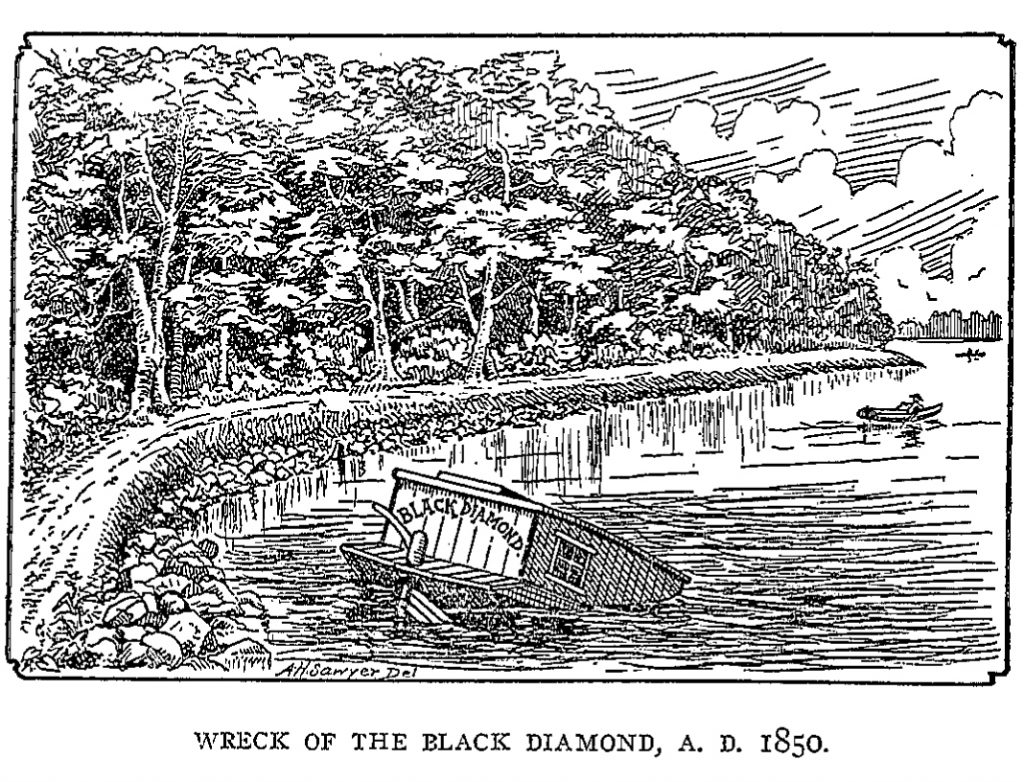Commodore Steve Harris – February, 2015
Many are familiar with the Gordon Lightfoot song, The Wreck of the Edmund Fitzgerald. It seems that most bodies of water have their own famous sinkings. Believe it or not, Buckeye Lake is no exception. The following story is condensed from Joseph Simpson, Jr.’s The Story of Buckeye Lake.
In 1850, Mr. Simpson, Sr. of Somerset operated a “steam grist mill” near Thornville. Previous owners of the mill had been unable to make a go of it, primarily due to the cost of wood as fuel. Mr. Simpson, deciding to try his hand at making the venture profitable, ordered two boat loads of coal from the Hocking Valley, to be delivered by canal boat to Thornport. In those days, once entering the reservoir at the Minthorn Locks (the present location of the Seller’s Point Spillway), canal boats would be towed a mile and a half along Northbank where they would enter the “channel proper.” They would then be propelled by the use of long poles across the lake to their destination at the east end.
Today, we think of many areas of the lake as being quite shallow and, perhaps, treacherous. Compared to the canal days, however, the bottom of our lake is completely clear. Prior to the construction of the Licking Summit Reservoir, now Buckeye Lake, much of the area was dense forest of beech, elm, and sycamore. The area wasn’t cleared prior to flooding the reservoir leaving many trees to rot at the water’s surface. This resulted in a strange landscape filled with numerous hazards – stumps, dead trees, logs, and floating islands!

One fateful summer day in 1850, on journey to deliver coal to the Simpson Mill, the Black Diamond, under the command of one Captain Ward of Newark, entered the reservoir at Minthorn’s and began the long, difficult haul across the “level” of the reservoir. She was a flat-bottomed scow with bow and aft cabins and a midship cargo capacity of about sixty ton. Loaded down to the 3-foot mark, she pulled along the towpath under fair headway, causing the line to slack and pull under a long half-sunken log. The driver stopped the mule team, but the boat, as boats do when underway, continued forward, further complicating the situation as the line pulled to the bottom collecting “a hundred pounds of reservoir moss, clinging and dripping.” They got the canal boat under control, cleared the moss and continued along the uneven coast of Northbank. Such was their journey for nearly a mile until they arrived at “the fatal curve.” According to Simpson, “A siren with her song could not have lured our seafarers more effectually…” Having already encountered significant difficulty and hazards, and being unfamiliar with the fact that the waters offshore were more treacherous than those near the bank, the helmsmen permitted his craft to “sheer,” or change course, drifting further into the reservoir instead of hugging the shoreline. “She struck fairly and with such impact that a large hole was ripped in her bottom, helplessly impaling and allowing her to rapidly fill with water.” Acting quickly, the crew was able to pull the stern of the boat into the bank and all hands safely made it to shore. The Black Diamond, however, rapidly filled, broke into two, and sank to the bottom.
For many years following, the Black Diamond furnished coal to the snakehunters – a term for the locals who lived along the reservoir and canal route – and farmers of the area who were willing to harvest it from the wreckage. The location of the wreckage was later to become known as “Black Diamond Bend.” It appears from Simpson’s maps, that it is at approximately 4000-4100 Northbank Rd. today.
Incidentally, it is in this same location, 18 years earlier, in 1832 that the embankment holding in the reservoir failed – causing great flooding in the South Fork Valley. But, that’s another story for another day.
UPDATE
The Wreck of the Black Diamond has been FOUND!
In February of 2016, during the dam remediation project, pieces of the Black Diamond wreckage were found off Northbank near Black Diamond Point.
CLICK HERE
to read J-Me Braig’s account of the discovery
